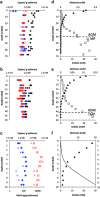Archaea of the Miscellaneous Crenarchaeotal Group are abundant, diverse and widespread in marine sediments
- PMID: 22551871
- PMCID: PMC3449235
- DOI: 10.1038/ismej.2012.37
Archaea of the Miscellaneous Crenarchaeotal Group are abundant, diverse and widespread in marine sediments
Abstract
Members of the highly diverse Miscellaneous Crenarchaeotal Group (MCG) are globally distributed in various marine and continental habitats. In this study, we applied a polyphasic approach (rRNA slot blot hybridization, quantitative PCR (qPCR) and catalyzed reporter deposition FISH) using newly developed probes and primers for the in situ detection and quantification of MCG crenarchaeota in diverse types of marine sediments and microbial mats. In general, abundance of MCG (cocci, 0.4 μm) relative to other archaea was highest (12-100%) in anoxic, low-energy environments characterized by deeper sulfate depletion and lower microbial respiration rates (P=0.06 for slot blot and P=0.05 for qPCR). When studied in high depth resolution in the White Oak River estuary and Hydrate Ridge methane seeps, changes in MCG abundance relative to total archaea and MCG phylogenetic composition did not correlate with changes in sulfate reduction or methane oxidation with depth. In addition, MCG abundance did not vary significantly (P>0.1) between seep sites (with high rates of methanotrophy) and non-seep sites (with low rates of methanotrophy). This suggests that MCG are likely not methanotrophs. MCG crenarchaeota are highly diverse and contain 17 subgroups, with a range of intragroup similarity of 82 to 94%. This high diversity and widespread distribution in subsurface sediments indicates that this group is globally important in sedimentary processes.
Figures






Similar articles
-
Environmental controls on intragroup diversity of the uncultured benthic archaea of the miscellaneous Crenarchaeotal group lineage naturally enriched in anoxic sediments of the White Oak River estuary (North Carolina, USA).Environ Microbiol. 2015 Jul;17(7):2228-38. doi: 10.1111/1462-2920.12659. Epub 2015 Jan 30. Environ Microbiol. 2015. PMID: 25331558
-
Diversity and distribution of methanotrophic archaea at cold seeps.Appl Environ Microbiol. 2005 Jan;71(1):467-79. doi: 10.1128/AEM.71.1.467-479.2005. Appl Environ Microbiol. 2005. PMID: 15640223 Free PMC article.
-
Stratified communities of active archaea in shallow sediments of the Pearl River Estuary, Southern China.Curr Microbiol. 2013 Jul;67(1):41-50. doi: 10.1007/s00284-013-0320-y. Epub 2013 Feb 13. Curr Microbiol. 2013. PMID: 23404650
-
Uncultured archaea in deep marine subsurface sediments: have we caught them all?ISME J. 2008 Jan;2(1):3-18. doi: 10.1038/ismej.2007.90. Epub 2007 Nov 8. ISME J. 2008. PMID: 18180743 Review.
-
New insights into the coal-associated methane architect: the ancient archaebacteria.Arch Microbiol. 2024 Apr 25;206(5):234. doi: 10.1007/s00203-024-03961-1. Arch Microbiol. 2024. PMID: 38664262 Review.
Cited by
-
Diversity of Bathyarchaeia viruses in metagenomes and virus-encoded CRISPR system components.ISME Commun. 2024 Jan 10;4(1):ycad011. doi: 10.1093/ismeco/ycad011. eCollection 2024 Jan. ISME Commun. 2024. PMID: 38328448 Free PMC article.
-
The Impact of Methane on Microbial Communities at Marine Arctic Gas Hydrate Bearing Sediment.Front Microbiol. 2020 Sep 24;11:1932. doi: 10.3389/fmicb.2020.01932. eCollection 2020. Front Microbiol. 2020. PMID: 33071992 Free PMC article.
-
Genomic and enzymatic evidence for acetogenesis among multiple lineages of the archaeal phylum Bathyarchaeota widespread in marine sediments.Nat Microbiol. 2016 Apr 4;1(6):16035. doi: 10.1038/nmicrobiol.2016.35. Nat Microbiol. 2016. PMID: 27572832
-
Response of Archaeal and Bacterial Soil Communities to Changes Associated with Outdoor Cattle Overwintering.PLoS One. 2015 Aug 14;10(8):e0135627. doi: 10.1371/journal.pone.0135627. eCollection 2015. PLoS One. 2015. PMID: 26274496 Free PMC article.
-
Marine Deep Biosphere Microbial Communities Assemble in Near-Surface Sediments in Aarhus Bay.Front Microbiol. 2019 Apr 12;10:758. doi: 10.3389/fmicb.2019.00758. eCollection 2019. Front Microbiol. 2019. PMID: 31031732 Free PMC article.
References
-
- Boetius A, Ravenschlag K, Schubert C, Rickert D, Widdel F, Gieseke A, et al. A marine microbial consortium apparently mediating anaerobic oxidation of methane. Nature. 2000;407:623–626. - PubMed
-
- Brochier-Armanet C, Boussau B, Gribaldo S, Forterre P. Mesophilic crenarchaeota: proposal for a third archaeal phylum, the Thaumarchaeota. Nat Rev Microbiol. 2008;6:245–252. - PubMed
Publication types
MeSH terms
Substances
LinkOut - more resources
Full Text Sources
Molecular Biology Databases

